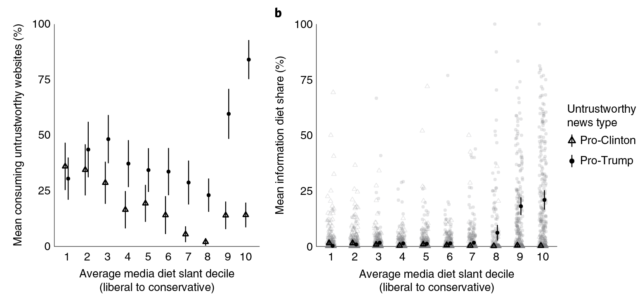
Partisan incorrect information on-line is a minimum of partly a bit of of a chicken-and-egg drawback. There’s the availability on one aspect, coming partly from politically motivated internet sites indistinguishable from propaganda but additionally from some who’re simply looking to make a greenback bringing in clicks with pretend headlines. However there’s additionally the call for to believe—the ones other people voraciously browsing to sate their starvation for bias-confirming outrage. To grasp the level of the issue, it is helping to have a look at each side of this dating. What incorrect information is floating round, and who’s eating it?
In a brand new learn about, Andy Wager, Brendan Nyhan, and Jason Reifler took benefit of survey information monitoring the Internet histories of round 2,500 other people within the month earlier than the 2016 US election. Blended with some demographic survey information on such things as their most well-liked candidate for president, the researchers had been in a position to damage down who was once studying which articles.
Who publishes what
The researchers depended on a earlier learn about’s checklist of “untrustworthy” websites. This incorporated a number of hundred which may be quite described as pretend but additionally over 100 that run afoul of fact-checkers and had been made up our minds to lack editorial requirements. Amongst that checklist are conspiracy-spreading websites like InfoWars and Herbal Information, hyperpartisan websites like Ben Shapiro’s Day-to-day Twine, or even some tabloids like The Categorical.
Total, virtually part of the folks collaborating visited a minimum of one article from a site on that checklist throughout the learn about length. However the ones articles accounted for simplest 6 p.c of all information tales learn. Those numbers weren’t flippantly allotted around the political spectrum, even though. About 57 p.c of Trump supporters within the team visited an untrustworthy web page once or more, amounting to about 11 p.c of general information intake. For the Clinton supporters within the team, it was once 28 p.c of other people visiting a minimum of one article, for 1 p.c in their general information intake.
And drilling deeper into the knowledge, a somewhat small team of other people is chargeable for many of the visits to untrustworthy websites. The researchers categorised other people by means of the ideological slant in their “information nutrition,” from the ones whose studying is ruled by means of liberal websites to people who simplest learn conservative websites. The 20 p.c of other people farthest to the conservative finish of the spectrum accounted for just about two-thirds of the untrustworthy articles learn.
A variety of assets
However even in that team, incorrect information junk meals didn’t essentially dominate the nutrition. It accounted for roughly 20 p.c in their information consumption. That’s partially for the reason that individuals who learn probably the most information articles from extra respected websites—probably the most voracious information shoppers—had been additionally the possibly to have run into a minimum of one untrustworthy article.

The following obtrusive query is whether or not persons are discovering those untrustworthy websites via Fb or another platform. The learn about may just simplest assess this in a fairly roundabout means, by means of checking whether or not one thing like Fb, Twitter, Google, or Internet-based e-mail seems within the browser historical past proper earlier than the URL of passion. Unsurprisingly, Fb popped up probably the most, at about 15 p.c of the time. Webmail got here in 2nd at 10 p.c, whilst Google and Twitter had been beneath five p.c.
The researchers additionally seemed for fact-check articles in the ones browser histories and located a few quarter of other people visited a minimum of one. That quantity comprises about part of those that visited untrustworthy articles, which means they had been extra most likely than a normal reader to test their info. A minimum of a few of their info. Of the 111 individuals who learn an editorial from a listing the researchers knew have been fact-checked, simplest 3 had learn the corresponding truth examine.
The researchers say this offers extra proof that truth assessments have most commonly failed to achieve the individuals who wish to see them maximum. It’s value noting, even though, that this knowledge predates most of the efforts by means of platforms like Fb to spotlight truth assessments for customers who engage with an editorial that was once rated false.
Total, the researchers conclude that “in style hypothesis concerning the incidence of publicity to untrustworthy internet sites has been overstated.” In fact, no longer the whole thing is captured of their dataset, like content material seen purely inside of Fb, as an example, or the results of incorrect information at the broader knowledge ecosystem. However this can be a distinctive learn about that helps what others have discovered—a somewhat small fraction of the general public is eating a lot of what the researchers name “factually doubtful content material.”
Nature Human Habits, 2020. DOI: 10.1038/s41562-Zero20-0833-x (About DOIs).



